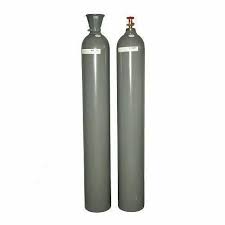Carbon dioxide is a chemical compound with the chemical formula CO2. It is made up of molecules that each have one carbon atom covalently double bonded to two oxygen atoms. It is found in the gas state at room temperature and at normally-encountered concentrations it is odorless. As the source of carbon in the carbon cycle, atmospheric CO2 is the primary carbon source for life on Earth. In the air, carbon dioxide is transparent to visible light but absorbs infrared radiation, acting as a greenhouse gas. Carbon dioxide is soluble in water and is found in groundwater, lakes, ice caps, and seawater. It is a trace gas in Earth's atmosphere at 421 parts per million (ppm), [a] or about 0.042% (as of May 2022) having risen from pre-industrial levels of 280 ppm or about 0.028%.[10][11] Burning fossil fuels is the main cause of these increased CO2 concentrations, which are the primary cause of climate change.[12] Its concentration in Earth's pre-industrial atmosphere since late in the Precambrian was regulated by organisms and geological features. Plants, algae and cyanobacteria use energy from sunlight to synthesize carbohydrates from carbon dioxide and water in a process called photosynthesis, which produces oxygen as a waste product.[13] In turn, oxygen is consumed and CO2 is released as waste by all aerobic organisms when they metabolize organic compounds to produce energy by respiration.[14] CO2 is released from organic materials when they decay or combust, such as in forest fires. When carbon dioxide dissolves in water, it forms carbonate and mainly bicarbonate (HCO−3), which causes ocean acidification as atmospheric CO2 levels increase.[15] Carbon dioxide is 53% more dense than dry air, but is long lived and thoroughly mixes in the atmosphere. About half of excess CO2 emissions to the atmosphere are absorbed by land and ocean carbon sinks.[16] These sinks can become saturated and are volatile, as decay and wildfires result in the CO2 being released back into the atmosphere.[17] CO2 is eventually sequestered (stored for the long term) in rocks and organic deposits like coal, petroleum and natural gas.
Chat with us on WhatsApp
×
This is your website preview.
Currently it only shows your basic business info. Start adding relevant business details such as description, images and products or services to gain your customers attention by using Boost 360 android app / iOS App / web portal.

2025-01-21T04:52:29
Carbon dioxide is a chemical compound with the chemical formula CO2. It is made up of molecules that each have one carbon atom covalently double bonded to two oxygen atoms. It is found in the gas state at room temperature and at normally-encountered concentrations it is odorless. As the source of carbon in the carbon cycle, atmospheric CO2 is the primary carbon source for life on Earth. In the air, carbon dioxide is transparent to visible light but absorbs infrared radiation, acting as a greenhouse gas. Carbon dioxide is soluble in water and is found in groundwater, lakes, ice caps, and seawater. It is a trace gas in Earth's atmosphere at 421 parts per million (ppm), [a] or about 0.042% (as of May 2022) having risen from pre-industrial levels of 280 ppm or about 0.028%.[10][11] Burning fossil fuels is the main cause of these increased CO2 concentrations, which are the primary cause of climate change.[12] Its concentration in Earth's pre-industrial atmosphere since late in the Precambrian was regulated by organisms and geological features. Plants, algae and cyanobacteria use energy from sunlight to synthesize carbohydrates from carbon dioxide and water in a process called photosynthesis, which produces oxygen as a waste product.[13] In turn, oxygen is consumed and CO2 is released as waste by all aerobic organisms when they metabolize organic compounds to produce energy by respiration.[14] CO2 is released from organic materials when they decay or combust, such as in forest fires. When carbon dioxide dissolves in water, it forms carbonate and mainly bicarbonate (HCO−3), which causes ocean acidification as atmospheric CO2 levels increase.[15] Carbon dioxide is 53% more dense than dry air, but is long lived and thoroughly mixes in the atmosphere. About half of excess CO2 emissions to the atmosphere are absorbed by land and ocean carbon sinks.[16] These sinks can become saturated and are volatile, as decay and wildfires result in the CO2 being released back into the atmosphere.[17] CO2 is eventually sequestered (stored for the long term) in rocks and organic deposits like coal, petroleum and natural gas.
2025-01-21T04:52:29
Keywords
- 421 parts
- 280 ppm
- released back
- produce energy
- aerobic organisms
- waste product13
- million ppm
- natural gas
- coal petroleum
- long term
- wildfires result
- long lived
- bicarbonate hco3
- forms carbonate
- forest fires
- turn oxygen
- produces oxygen
- synthesize carbohydrates
- climate change12
- trace gas
- visible light
- room temperature
- gas state
- oxygen atoms
- atmosphere17 co2
- respiration14 co2
- earths atmosphere
- organic deposits
- organic materials
- dry air
- ocean acidification
- preindustrial levels
- normallyencountered concentrations
- chemical compound
- carbon dioxide
- primary carbon source
- earths preindustrial atmosphere
- air carbon dioxide
- increased co2 concentrations
- chemical formula co2
- ocean carbon sinks16
- carbon dioxide dissolves
- excess co2 emissions
- metabolize organic compounds
- eventually sequestered stored
- process called photosynthesis

Submit Your Enquiry